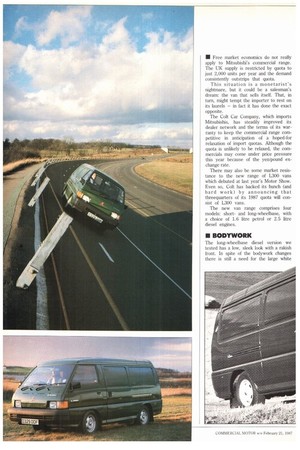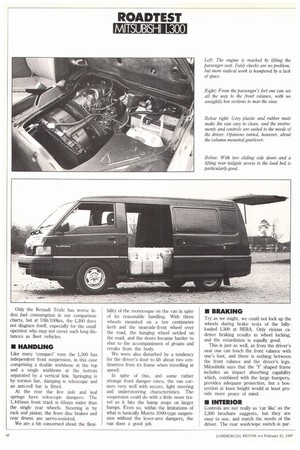MITSUBISHI'S CITY SLICKER
Page 41

Page 40

Page 42

Page 43

If you've noticed an error in this article please click here to report it so we can fix it.
Demand for Mitsubishi CVs regularly exceeds the importer's quota. Far from resting on its
laurels, however, Colt is concentrating on a newcomer: the L300 panel van. • Free market economics do not really apply to Mitsubishi's commercial range. The UK supply is restricted by quota to just 2,000 units per year and the demand consistently outstrips that quota.
This situation is a monetarist's nightmare, but it could be a salesman's dream: the van that sells itself. That, in turn, might tempt the importer to rest on its laurels — in fact it has done the exact opposite.
The Colt Car Company, which imports Mitsubishis, has steadily improved its dealer network and the terms of its warranty to keep the commercial range competitive in anticipation of a hoped-for relaxation of import quotas. Although the quota is unlikely to be relaxed, the commercials may come under price pressure this year because of the yen/pound exchange rate.
There may also be some market resistance to the new range of L300 vans which debuted at last year's Motor Show. Even so, Colt has backed its hunch (and hard work) by announcing that threequarters of its 1987 quota will consist of L300 vans.
The new van range comprises four models: shortand long-wheelbase, with a choice of 1.6 litre petrol or 2.5 litre diesel engines.
• BODYWORK
The long-wheelbase diesel version we tested has a low, sleek look with a rakish front. In spite of the bodywork changes there is still a need for the large white
identification letters at the rear of the van. Without them, the shortsighted could be forgiven for mistaking the Mitsubishi for any one of a myriad of Japanese 'compact vans.
The L300 range was the first UK van to offer twin side doors as a standard fitment, and the new vans continue this tradition. We found the doors to be very useful when loading the van, although they may have forced Mitsubishi to save weight elsewhere to maintain the payload value (see under 'handling' p40).
A payload of 1,050kg gives the L300 a slight advantage over the Ford Transit and Renault Trafic, but it ranks behind the Freight Rover Sherpa and the Bedford Midi. Generous plated axle weights mean
that the load can be distributed evenly over the load bed, and the 5.67m2 load volume is very respectable.
Although the standard of interior specification is high, Mitsubishi has not seen fit to include any form of load restraint or any means of attaching restraints to the van. Even with the slippery carpet removed and the load resting on the swaged steel floor of the van, the gavel-filled bottles of our test load slid all over the place when cornering.
This came to a head during acceleration tests at the Motor Industry Research Association proving ground when the load slipped back a couple of centimetres, burst the tailgate catch and bent the unsupported sides of the panel.
• DRIVELINE
The driveline on the L300 is fairly conventional by the standards of current small van design. The engine is a four-cylinder OHC, IDI 2.5 litre diesel unit with a rotary injection pump.
An all-synchromesh five-speed gearbox takes the drive to a live rear axle mounted on semi-elliptic leaf springs.
It isn't the most economical unit but the engine has plenty of power. In traffic, the flexibility of the unit means there is no need to 'row' the van along by continuously changing gear.
• PERFORMANCE
On A roads and motorways the L300 makes grand progress at the legal limit, and is not slowed down by hills. Acceleration is also brisk and the gear ratios are well-spaced without compromising the top speed of the vehicle.
Even among Commercial Motor staff opinions differ on the merits of a columnmounted gearlever. For some it is a convenient, space-saving device that presents no problems; others feel that a floor-mounted lever is infinitely preferable. All are agreed that the columnmounted lever on the L300 is a poor example of the breed with a small, restrictive gate and rather slow synchromesh cones that hamper gear changing. Only the Renault Trafic has worse laden fuel consumption in our comparison charts, but at 10lit/100km, the L300 does not disgrace itself, especially for the small operator who may not cover such long distances as fleet vehicles.
• HANDLING
Like many 'compact' vans the L300 has independent front suspension, in this case comprising a double wishbone at the top and a single wishbone at the bottom separated by a vertical link. Springing is by torsion bar, damping is telescopic and an anti-roll bar is fitted.
At the rear the live axle and leaf springs have telescopic dampers. The 1,445mm front track is 65mm wider than the single rear wheels. Steering is by rack and pinion; the front disc brakes and rear drums are servo-assisted.
We are a bit concerned about the flexi bility of the monocoque on the van in spite of its reasonable handling. With three wheels mounted on a ten centimetre kerb and the nearside-front wheel over the road, the hanging wheel settled on the road, and the doors became harder to shut to the accompaniment of groans and creaks from the body.
We were also disturbed by a tendency for the driver's door to lift about two centimetres from its frame when travelling at speed.
In spite of this, and some rather strange front damper rates, the van corners very well with secure, light steering and understeering characteristics. The suspension could do with a little more travel as it hits the bump stops on larger bumps. Even so, within the limitations of what is basically Morris 1000-type suspension without the lever-arm dampers, the van does a good job.
• BRAKING
Try as we might, we could not lock up the wheels during brake tests of the fullyloaded L300 at MIRA. Only vicious cadence braking results in wheel locking, and the retardation is equally good.
This is just as well, as from the driver's seat one can touch the front valance with one's foot, and there is nothing between the front valance and the driver's legs. Mitsubishi says that the 'Y' shaped frame includes an impact absorbing capability which, combined with the large bumpers, provides adequate protection, but a boxsection at knee height would at least provide more peace of mind.
• INTERIOR
Controls are not really as 'car like' as the L300 brochure suggests, but they are easy to use, and match the needs of the driver. The rear wash/wipe switch is par ticularly good, providing an intermittent facility on demand.
An excellent stereo radio is fitted and mention must be made of the hamburger box masquerading as a horn button in the middle of the steering wheel! The grey plastic facia is easy to clean, and practical lloormats can be removed so that the cab could virtually be hosed out.
The seats are comfortable even on a long journey, with raised side-cushions which provide some lateral location when cornering. Like so many van heaters, this one fails to provide cool air to breathe with warm air to the feet, although the recirculating air is a good feature which prevents exhaust fumes being pulled into the cab when in traffic.
Touches like push-button door locks contrast with fiddly features like the interior fuel cap release which, with three passengers, is virtually inaccessible.
• SUMMARY
In the city the excellent brakes, reasonable handling, manoeuvrability and flexible engine make the van a good proposition. For the owner/driver, who will treat the van with respect, a Mitsubishi L300 could prove the right choice.
Motorways and A roads show up the limitations of the 'compact' van idea. Flimsy doors, not-so-good fuel consumption, a poor gear change, and doubts over the light construction will not endear this van to the fleet operator, whose drivers may not afford the L300 the respect it needs.
▪ by Andrew English












































































